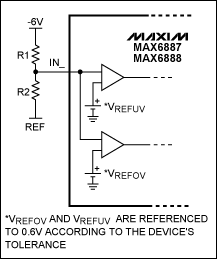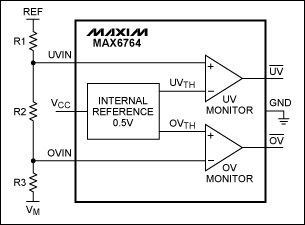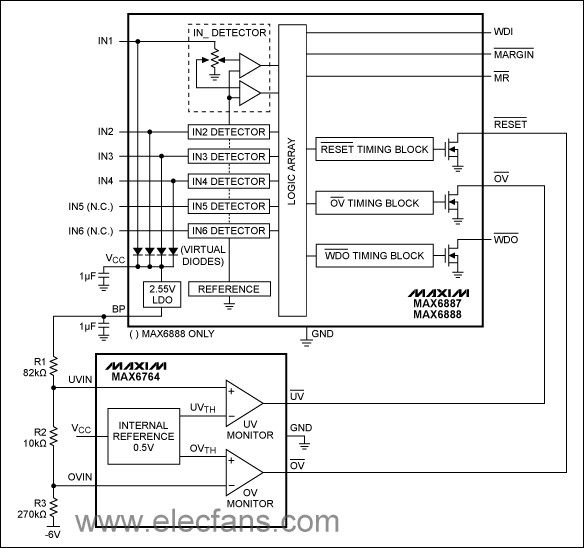
A similar version of this arTIcle appeared in the January 1, 2008 issue of PD magazine.
MulTIvoltage supply supervisors (such as the MAX6887) provide several voltage-detector inputs for positive voltages, each with factory-set thresholds for undervoltage and overvoltage. The acitve-low RESET output asserts when any input drops below its undervoltage threshold, or when you assert the manual reset (MR). The acitve-low OV output asserts when any input exceeds its overvoltage threshold. These capabilities are useful, but telecom applications often require that you monitor a negative supply voltage for the RF circuitry as well.
To monitor negative voltage you can make use of the MAX6887 adjustable-input option (Figure 1), in which a level-shifting circuit connects one side of the resistive divider to a positive level and the other side to the negative voltage. This approach, however, produces inverted output logic. If, for example, you monitor -6V with thresholds at -6.5V and -5.5V, the circuit asserts acitve-low UV when VIN = -6.5V and acitve-low OV when VIN = -5.5V.

Figure 1. MAX6887 adjustable input option.
The circuit of Figure 2 overcomes this limitation by adding a simple window-detector IC (Figure 3) to monitor the negative supply. The detector's acitve-low UV output connects to the multivoltage supervisor's acitve-low OV output, and the detector's acitve-low OV output connects to the supervisor's acitve-low RESET output. Thus, the acitve-low RESET output goes low when the negative voltage decreases to -5.5V, and the acitve-low OV output asserts low when the negative voltage increases to -6.5V. Three resistors (R1–R3) set the under- and over-voltage thresholds UV and OV. R1 connects to a positive reference voltage, and R3 connects to the monitored negative voltage.

Figure 2. This IC (in SOT23 package) is a simple window comparator that monitors a supply voltage with separate under/overvoltage outputs.

Figure 3. By combining the circuits of Figures 1 and 2, one pair of terminals warns of under- or over-voltage for multiple positive voltages and one negative voltage.
If your system doesn't include a positive reference voltage, you can use the supervisor's 2.55V BP output. To maximize DC accuracy, the sum of R1 + R2 + R3 should draw only a few microamps from the BP output. Using the principle of superposition, you can then calculate the voltages at UVIN and OVIN for any given set of resistor values as follows:
where VM is the monitored negative supply voltage.
Operation of the Figure 3 circuit is illustrated in the scope shot of Figure 4, in which the yellow trace (CH1) represents the monitored negative voltage VM as it ranges from 0V to -7V. Other traces are:
R1 (black) = UVIN
CH2 (blue) = MAX6764 acitve-low UV
CH3 (green) = OVIN
CH4 (pink) = MAX6764 acitve-low OV

Figure 4. These waveforms illustrate operation of the Figure 3 circuit.
The nominal value for the monitored negative voltage is -6V. Both acitve-low OV and acitve-low UV outputs have a 10kΩ pullup to 5V, and the VCC terminals of both ICs connect to a 5V supply. The MAX6764 Output acitve-low UV (MAX6887 acitve-low OV Output) goes low at VM = -6.55V (and goes high at VM = -6.52V). The MAX6764 output acitve-low OV (MAX6887 acitve-low RESET Output) goes low at VM = -5.53V (and goes high at VM = -5.55V).
欢迎分享,转载请注明来源:内存溢出

 微信扫一扫
微信扫一扫
 支付宝扫一扫
支付宝扫一扫
评论列表(0条)